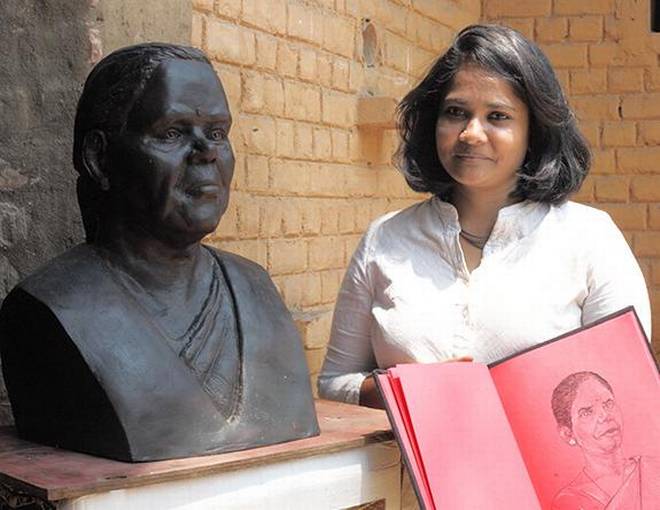Archiving Labour examines history, society and art through the lens of labour
Between sweltering skies and sea breeze at the tiled-roof veranda of Spaces, a prodigious handcrafted volume titled ‘Create’ is the first exhibit. In it, student artist Kamashewaran has explored the plight of bonded labourers at brick kilns in his village. We turn the pages to find endearing portraits of brick makers, and hand impressions alternating with words such as ‘sengal’ (brick). At the bottom, a brick sits in a deep receptacle, engraved with the word ‘Labour’. This bond between labour and creation is at the core of Archiving Labour curated by CP Krishnapriya, an alumnus of the College of Fine Arts.
Produced by a collective of 33 students from Government College of Fine Arts, Chennai and Kumbakonam, the exhibition, which was part of the Student Biennale, Kochi 2016-17, garnered a national award. Of 15 emerging curators, Krishnapriya won the Tata Trusts International Award, granting her a trip to experience the Venice and documenta Biennales.
Raison d’etre
Her vision for the year-long project was bi-fold — one, leading the students of the two schools to re-examine their artistic practice and two, re-visiting the Madras School to trace its roots to industrial crafts. On their trail, the artists discovered a brick kiln at the Chennai campus where bricks were once manufactured. The evidence, a replica of an old brick with the ‘School of Arts Madras’ insignia sits like an unassuming marker on a pedestal.
With intensive workshops for reading and criticism over four months, Krishnapriya steered the group away from the sacrosanct white cube gallery. The artists took the path less trodden, using low-cost and accessible materials to explore art in a small, meaningful way. The mysterious locked-up school museum became the imaginary site which photos, videos and impressions would bring alive. These innocuous exhibits are magical when you unlock their codes.
Positioned against the grand metaphor of the Triumph of Labour statue (1959) at the Marina by erstwhile sculptor and then Principal DP Roy Chowdhury, the artists queried — how does labour triumph? “Many of the students come from rural backgrounds and their families are engaged in brick making, weaving, metalwork and labour,” says Krishnapriya, whose mentoring opened channels for the students to examine their own origins and communities. Student artist Karthikeyan’s portrait of his father is accompanied by a sign, ‘My father is a signboard artist’, painted by his father. Such paradoxes resonate throughout the show.
The product of labour — be it a beautiful monument or a Kanjivaram saree — belongs to the one who commissions it, while its real makers are never credited. Material becomes message in Sindhuja’s portraits of weavers on silk sarees, documenting her family of weavers. And so, who do we celebrate? Artist Thalamuthu chose Revathy, a cleaner of railway tracks and made her bust, displayed at Chennai Central for several days.
“This was planned as an exhibition where you have to spend time, read the notes and make an effort,” says Krishnapriya. The exercises linked ‘how do you view?’ to ‘how are we viewed?’ using writing, sound recordings, photography and video, relatively inexpensive media. Reviving the context of the old photography department at the College of Arts, a group selected images from the British Library archives to compare anthropological views of Indians from the Colonial era with present day.
The artists posed, mimicking the earlier orchestrated set-ups: a girl with a food processor versus 20th Century women at grinding mills. In another exercise, P Parthik’s photo-collage of the hands of labourers from Kumbakonam show their hardships. Extensive sketchbooks of brick workers, railway cleaners and launderers reveal an empathetic understanding of the gaps in our society. A 10-paisa coin — a paltry sum paid for husking one coconut — is framed and positioned next to calloused hands.
The inquiry to find the artist’s role and the institution’s throws up several questions. Can anyone make art? Who can sculpt? Who can create? Here, the lens turns to people relegated to toil in our society, to ask: ‘Are not bricks, baskets and woven handloom, art?’
The exhibition with evening lectures is on at Spaces, Besant Nagar, till March 30.
source: http://www.thehindu.com / The Hindu / Home> Society / by Sujatha Shankar Kumar / March 28th, 2018
